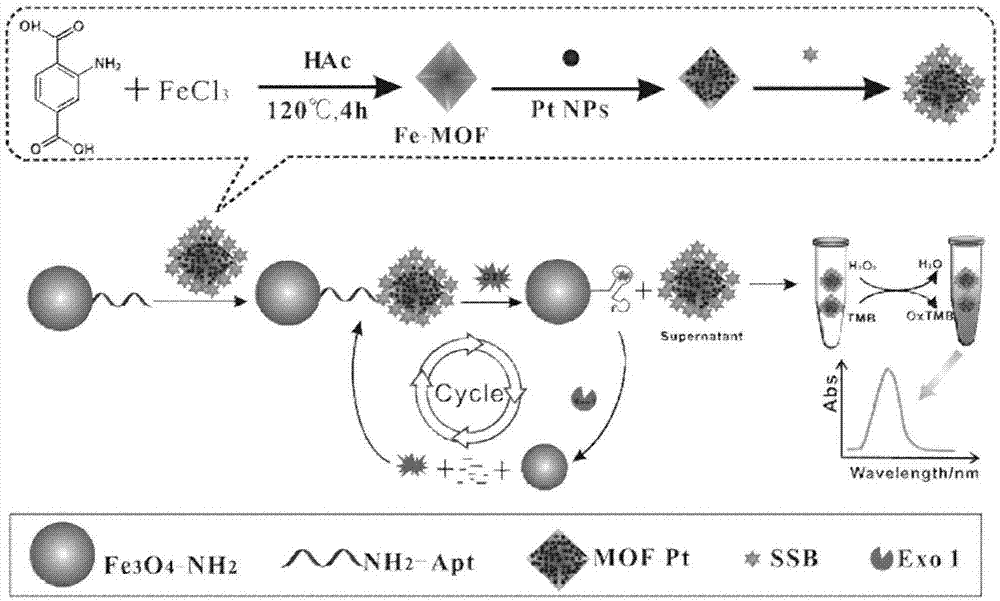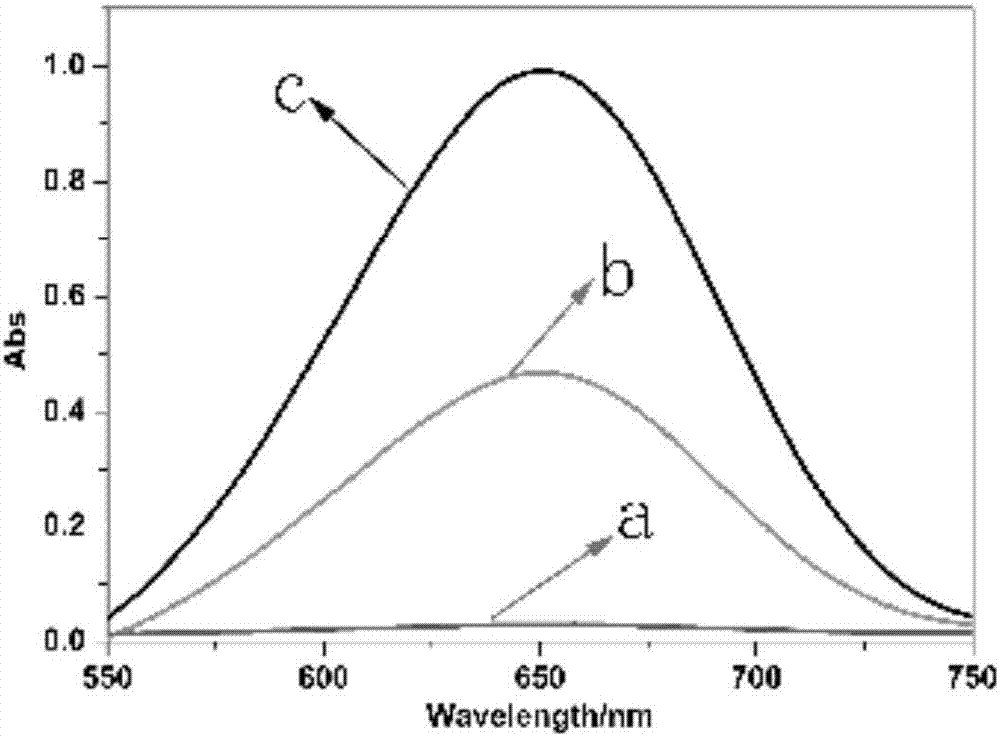A colorimetric detection probe for detecting terramycin in food and a detecting method thereof
A detection probe, oxytetracycline technology, applied in the colorimetric detection probe field of oxytetracycline, can solve problems such as enzyme activity interference, trace presence, matrix interference, etc., and achieve low detection limit, good specificity and selection The effect of sex, good application and development prospects
- Summary
- Abstract
- Description
- Claims
- Application Information
AI Technical Summary
Problems solved by technology
Method used
Image
Examples
Embodiment 1
[0031] like figure 1 As shown, this embodiment includes the following steps:
[0032] (1) Preparation of MOF-Pt composite material: first synthesize Fe-MIL-88, weigh 0.118g terephthalic acid and 0.187g FeCl respectively 3 ·6H 2O was dissolved in 15mL of DMF, then 3.45mmol of acetic acid solution was added, reacted in an oil bath at 110°C for 3h, cooled to room temperature to collect the precipitate; to synthesize Pt-PVP, 16.6mg of PVP was dissolved in 45mL of ethanol, and then 5mL of chloroplatinic acid was added dropwise, Then the reaction was stirred at room temperature for 2 min, and finally refluxed for 3 h to collect the precipitated Pt NPs-PVP; finally, the Pt NPs-PVP was added dropwise to the Fe-MIL-88 solution under vigorous stirring, and the Pt NPs-PVP and Fe-MIL The ratio of -88 was 1:1, reacted at room temperature for 2 hours, and finally collected the precipitate by centrifugation to obtain the MOF-Pt composite material.
[0033] (2) Preparation of composite pro...
Embodiment 2
[0045] like figure 1 As shown, this embodiment includes the following steps:
[0046] (1) Preparation of MOF-Pt composite material: first synthesize Fe-MIL-88, weigh 0.354g terephthalic acid and 0.561g FeCl respectively 3 6H 2 O was dissolved in 45mL of DMF, then 7.20mmol of acetic acid solution was added, the oil bath was reacted at 120°C for 4h, and the precipitate was collected after cooling to room temperature; to synthesize Pt-PVP, 33.2mg of PVP was dissolved in 60mL of ethanol, and then 10mL of chloroplatinic acid was added dropwise. Then the reaction was stirred at room temperature for 5 min, and finally refluxed for 5 h to collect the precipitated Pt NPs-PVP; finally, the Pt NPs-PVP was added dropwise to the Fe-MIL-88 solution under vigorous stirring, and the Pt NPs-PVP and Fe-MIL The ratio of -88 was 1:2, reacted at room temperature for 5 hours, and finally collected the precipitate by centrifugation to obtain the MOF-Pt composite material.
[0047] (2) Preparatio...
Embodiment 3
[0059] like figure 1 As shown, this embodiment includes the following steps:
[0060] (1) Preparation of MOF-Pt composite material: first synthesize Fe-MIL-88, weigh 0.251g terephthalic acid and 0.356g FeCl 3 6H 2 O was dissolved in 30mL of DMF, then 5.20mmol of acetic acid solution was added, the oil bath was reacted at 115°C for 4h, and the precipitate was collected after cooling to room temperature; to synthesize Pt-PVP, 20.2mg of PVP was dissolved in 45mL of ethanol, and then 6mL of chloroplatinic acid was added dropwise. Then stir the reaction at room temperature for 3 min, and finally reflux for 3 h to collect the precipitated Pt NPs-PVP; finally, add the Pt NPs-PVP dropwise to the Fe-MIL-88 solution under vigorous stirring, Pt NPs-PVP and Fe-MIL The ratio of -88 was 1:1.5, reacted at room temperature for 3 hours, and finally collected the precipitate by centrifugation to obtain the MOF-Pt composite material.
[0061] (2) Preparation of composite probe solution: Apt ...
PUM
 Login to View More
Login to View More Abstract
Description
Claims
Application Information
 Login to View More
Login to View More - R&D
- Intellectual Property
- Life Sciences
- Materials
- Tech Scout
- Unparalleled Data Quality
- Higher Quality Content
- 60% Fewer Hallucinations
Browse by: Latest US Patents, China's latest patents, Technical Efficacy Thesaurus, Application Domain, Technology Topic, Popular Technical Reports.
© 2025 PatSnap. All rights reserved.Legal|Privacy policy|Modern Slavery Act Transparency Statement|Sitemap|About US| Contact US: help@patsnap.com



